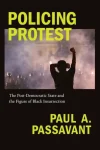Policing Protest: The Post-Democratic State and the Figure of Black Insurrection
 Author: Paul Passavant
Author: Paul Passavant
Publisher: Duke University Press, 2021. 368 pages.
Reviewer: Heidi Reynolds-Stentson | June 2023
One of the central claims of Paul Passavant’s Policing Protest: The Post-Democratic State and the Figure of Black Insurrection is that the policing of protest has become increasingly aggressive in recent decades and has coalesced into a new “security model” of protest policing that “goes beyond ordinary law enforcement yet stops short of total war.” Paul Passavant, Policing Protest: The Post-Democratic State and the Figure of Black Insurrection 204 (2021). Passavant problematizes the shift from the “escalated force” to “negotiated management” styles of protest policing (as described by John McCarthy, Clark McPhail, and their collaborators), and argues that negotiated management no longer holds court – and perhaps was always more of a promise than a reality. But Passavant quickly goes beyond documenting the shift towards increasingly aggressive protest policing and devotes most of his book to uncovering the interconnected forces which he argues led to this change, as well as what it reveals about the state of our democracy. He argues that multiple forces began to combine and constellate in the 1960s and 1970s set in motion by three interrelated crises: a crisis of democracy, an urban fiscal crisis, and a crime crisis. The more aggressive form of protest policing that grew out of this context, he argues, is simply one of the more visible manifestations of a new post-democratic, post-legitimation state formation which he terms “neoliberal authoritarianism.”
Passavant begins by arguing that, to some, the social progress of the civil rights movement was seen as a crisis of (too much) democracy as the political system became, as they saw it, overloaded by too much participation from the margins of society. Nixon’s campaign ran on these sentiments, arguing against the Kerner Report by arguing that the fault lies not with society but with the rioters.
At the same time, the perceived crime crisis helped fuel police militarization. Later, “broken windows” and zero tolerance policing, which in turn shaped protest policing practices. In drawing parallels between NYPD’s broken window policing and its approach to protest policing, Passavant also attends to the expressive nature of the “excesses” seen in both aggressive policing practices like Stop and Frisk and the repression (and even degradation) of protesters like those of the Occupy Wall Street and Black Lives Matter movements. Bringing attention to the affective and expressive dynamics of protest policing among those perpetuating it, is one of the many novel and important contributions of this book. Passavant’s idea that aggressive protest policing is in large part expressive also provides another way to understand the particularly heavy-handed response to protests against police brutality. Passavant explains, “In addition to high-ranking officers’ concerning role in the abuse of force was the disturbing fact that gratuitous police violence against protesters occurred while police had to have known they were being watched and video recorded as they reacted against protests of police abuse of force. This suggests that the police violence against protesters has an expressive element—the police response expressed opposition to BLM, to democratic assemblies, and the claim that police should be legally accountable. They were responding to political antagonism.” Id. at 21.
These two crises – the crime crisis and the crisis of democracy – were interrelated in the sense that “the crime crisis conflated civil rights demonstrations with crime, violence, and riots. Where many perceived the pursuit of justice, reactionaries simply saw crime.” Id. at 242. Meanwhile, as a result of the third crisis described by Passavant – the urban fiscal crisis of the 1970s – urban governments were compelled to become increasingly neoliberal and reoriented their efforts away from their residents and towards producing aesthetic and cultural experiences in order to compete for tourists, private investment, and the opportunity to host mega events or national special security events (NSSE). Hosting these mega events in turn leaves cities with a “security legacy” in the form of armored vehicles, weapons, and increased numbers of security cameras throughout the city. Id. at 10. Not only does this mean that police have more tools of repression at their disposal, but it also shifts their mandate to focus on preventing “disruptions to the production of cultural experiences or mega-events, whether such a disturbance comes from the visibly poor, crime or disaster, or a protest.” Id. at 241.
Throughout his discussion of the crime crises, urban fiscal crisis, and crisis of democracy, Passavant illuminates how the ghost of the “black insurrection” of the 1960s – alluded to in the title of the book – “haunts” all three crises and how “repressing this haunting figure’s appearance” became a driving force behind the emergence of the neoliberal authoritarian state. Id. at 15. While explaining changes in the policing of protest is the central focus of Policing Protest, in doing so Passavant reveals much more far-reaching, fundamental, and even more deeply concerning shifts in social control and governance in the contemporary U.S. Over the course of the book, Passavant draws on case studies of movements such as Occupy Wall Street and Black Lives Matter – and brings this together with legal history and evolving case law – and skillfully connects seemingly disconnected trends and features of contemporary life to construct a cohesive and novel understanding of the legal, political, and economic predicament in which we find ourselves.
The book is at once sweeping in its implications, nuanced in its arguments, and detailed in the evidence it brings to bear on these questions. It will be of great interest to scholars of social movements, policing, and law as well as a broader audience of those concerned about protecting the freedom to engage in dissent. While the arc of recent history that Passavant draws is undeniably bleak, he does not leave readers without hope. For example, after arguing that the form that policing, and protest policing specifically, has taken in recent decades is just one facet of “the antagonism between the neoliberal authoritarian state and the well-being of the people,” he adds, on a more hopeful note, that “Perhaps this is the fissure that we can use to open a space where we can begin assembling to determine a better life for ourselves.” Id. at 252.
Dr. Heidi Reynolds-Stenson is an Assistant Professor of Sociology at Colorado State University, Pueblo.


